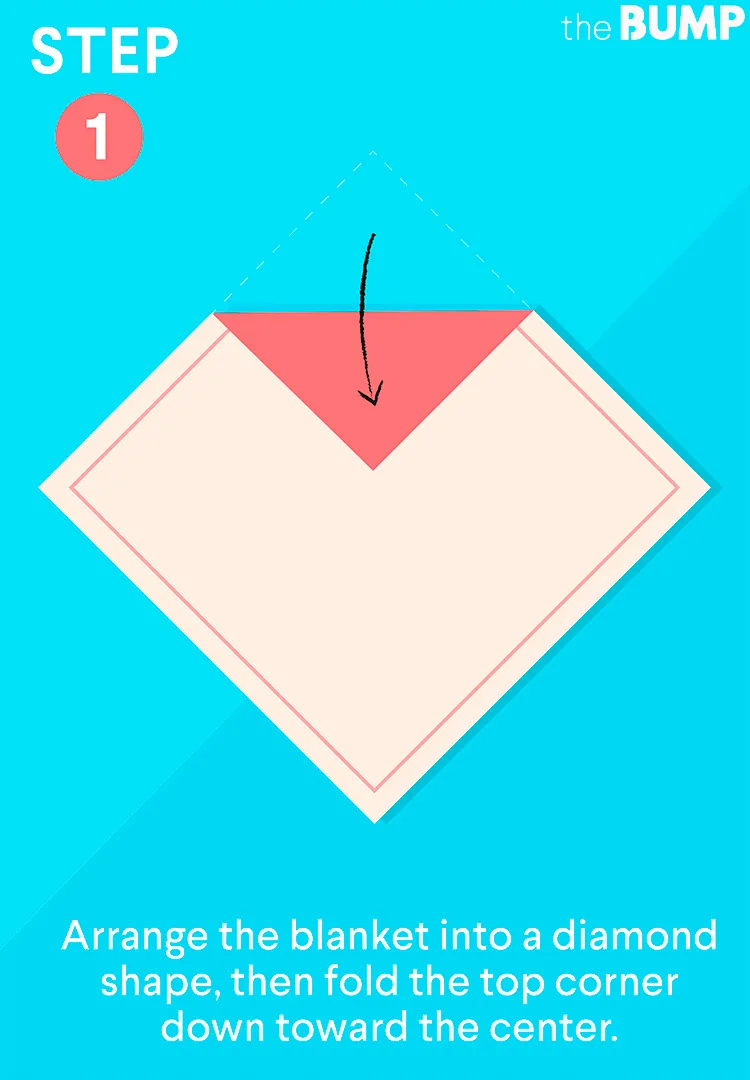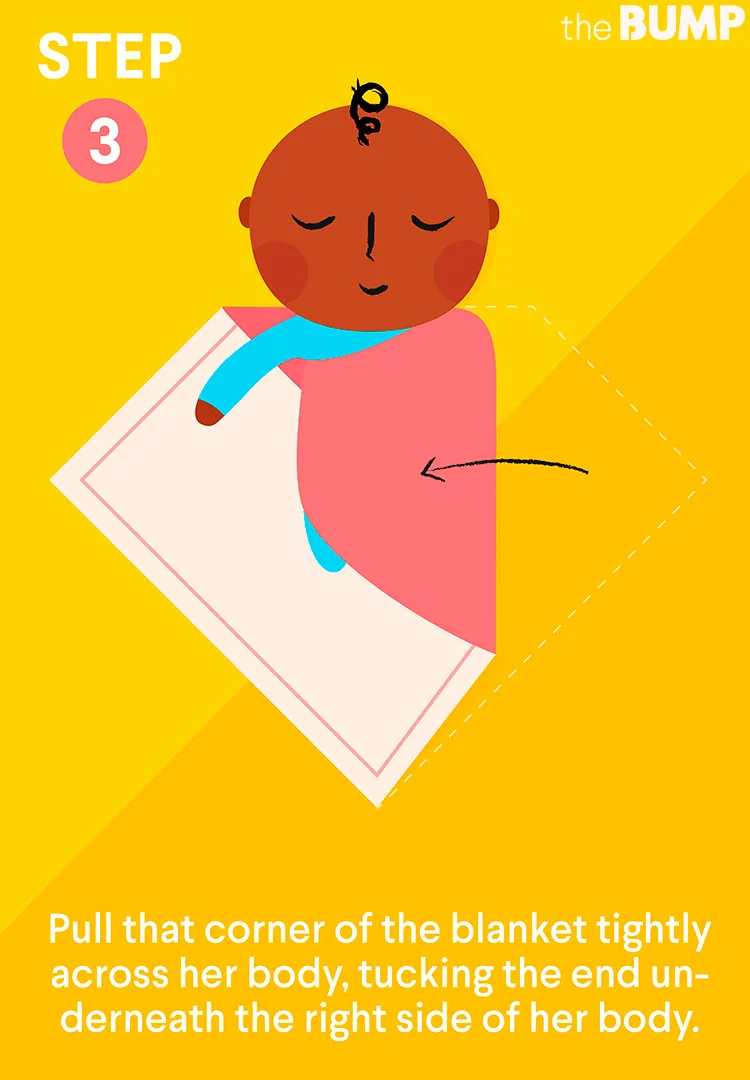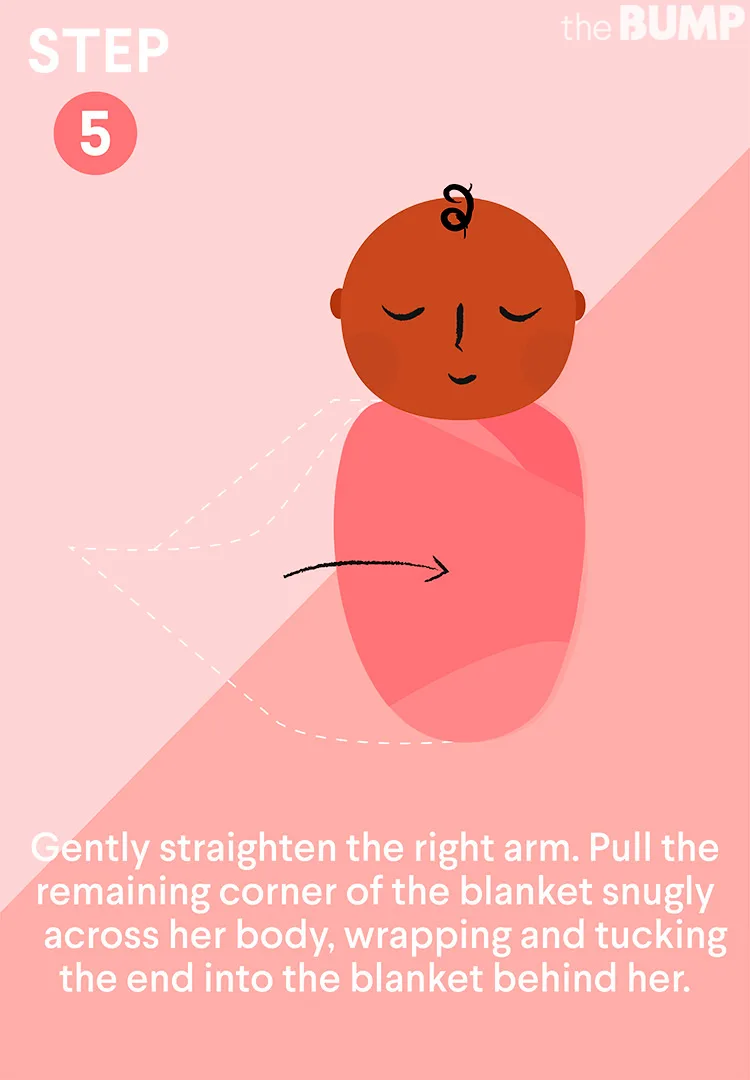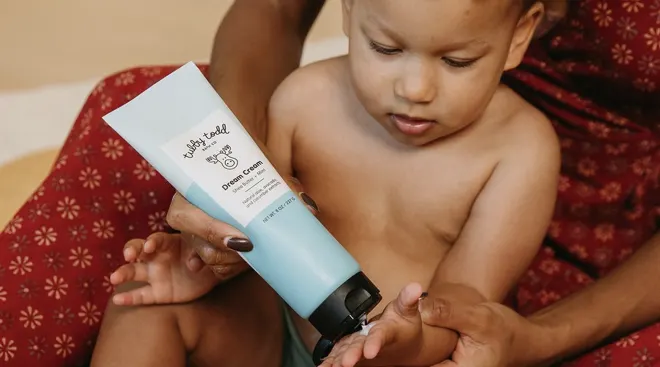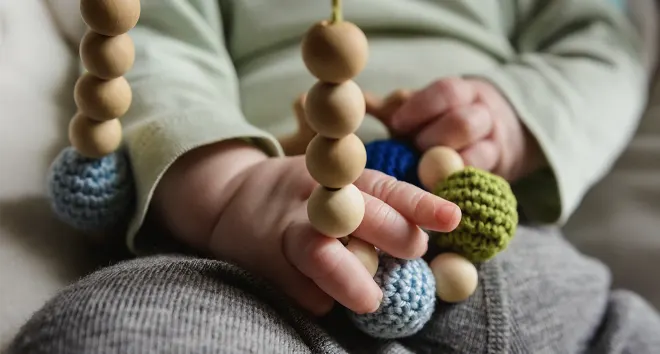How to Swaddle Baby Like a Pro
Baby having trouble sleeping? Crazy as it sounds to new parents, putting baby to bed in a burrito-style wrap—also known as swaddling—just might do the trick. Swaddling has been around for thousands of years. Parents have wrapped up babies in a swaddle to not only help them sleep but also simply to hold them, protect them and calm them down. It fell out of favor in the 18th century, but interest in its soothing powers returned around the 1970s. Today, as parents are finding a new appreciation for natural and age-old methods of caring for baby swaddling is enjoying what pediatrician Harvey Karp, MD, is calling a “renaissance.” Read on to find out how to swaddle a baby and why a swaddle might help calm your little one (and maybe score you some more sleep too).
Swaddling simply means tightly wrapping up baby in a blanket in such a way that makes them feel secure, like being back in their mom’s belly, all warm and comfy. You can swaddle baby from Day 1, for naps and nighttime sleep; it helps keep them feeling compact and cozy, and may even deter the jolting startle reflex. Doctors, including Karp, who wrote the national best-seller The Happiest Baby on the Block, strongly recommend the practice as a way to soothe babies. Furthermore, the American Academy of Pediatrics (AAP) also notes that swaddling can help encourage and enhance baby’s sleep.
“Swaddling creates the snug, familiar, soothing feeling a baby experienced in the womb before being born,” says Melissa Gersin, RN, a Boston-based maternity nurse and baby-brand product inventor. It makes baby feel safe, “because in the last few months before birth, baby didn’t have much space in the womb and could only make small movements,” she explains.
Babies can be swaddled anytime they’re fussy or seemingly crying for no reason (no dirty diaper, and you know they’re not hungry because you just fed them, etc.). “Being swaddled is like receiving a big hug,” Gersin says, and that snug, swaddled feeling can help keep baby calm, especially when combined with other baby-soothing techniques, such as swaying and making a loud ‘shh’ sound. When done correctly, she adds, swaddling can also help baby fall asleep faster and stay asleep longer.
We do a half swaddle. He hates his hands and arms tied down so we start the swaddle from under his arms. This seems to make us all happier.
Some parents wonder: Can swaddling cause Sudden Infant Death Syndrome (SIDS)? The answer is: Not directly. According to the American Academy of Pediatrics, swaddling allows baby to sleep more soundly (which is why parents swaddle in the first place); but decreased arousal has been linked to an increased risk of SIDS. A 2016 Pediatrics journal study reports that the recommendation to avoid having baby sleep on their side or stomach is especially important when babies are in a swaddle. So if you’re swaddling, make sure baby is on their back, and when they’re old enough to roll in their sleep, it’s best to stop swaddling altogether.
Still, swaddling may sound a bit counterintuitive. The AAP advises against giving a baby under 12 months a loose blanket or having any plush materials in their crib. This is among the reasons it’s essential to practice safe swaddling techniques. Here, a few important sleep safety tips to keep top of mind as you learn how to swaddle a baby:
- Always place baby on their back. Baby should be placed on their back on a firm surface for sleep. Once they show signs of rolling, it’s important to stop swaddling. (It’s the ABC’s of safe sleep. Baby should be “alone,” on their “back,” in a “crib.”)
- Avoid having plush or soft items in baby’s crib. Baby’s sleep space should be free of loose bedding, stuffed animals, blankets, pillows, bumpers and other items.
- Watch for overheating. You’ll want to opt for a soft, breathable swaddle blanket. Using a heavier blanket material may cause baby to overheat. If baby is sweating, flushed or breathing rapidly, they may need to lose a layer.
- Keep the swaddle snug, but not tight. It’s a fine line—you want your swaddle to be compact, but not restrictive. It’s important to ensure it won’t unravel, but it’s also critical that a swaddle doesn’t straighten or bind baby’s legs, as this can cause problems like hip dysplasia.
One of the easiest ways to learn how to swaddle a baby is to find a ready-made Velcro or zipper swaddle, in which you simply can tuck in your newborn or infant. But you can also swaddle baby using any large, thin and soft blanket. (To find your best options for baby, check out our swaddle blankets shopping guide).
Ask a nurse or pediatrician to help teach you how to swaddle a newborn at your first pediatrician’s exam (or before you even leave the hospital). You can also take a newborn-care class with your partner, where both of you can receive hands-on instruction on how to swaddle a baby. At home, follow these steps:
Step 1: Lay a thin, lightweight square blanket down on a flat surface so that it looks like a diamond. Fold the top corner down toward the center of the diamond; the top now forms a straight line.
Step 2: Place baby face up on the blanket so that their neck is along the top edge. One tip as you learn how to swaddle a newborn: Don’t let the blanket touch baby’s cheek. They may think it’s a breast—this could set off the rooting reflex and make them cry in confusion at not being fed.
Step 3: Gently hold baby’s left arm down along their side. (If baby’s arms are bent over their chest, they can wriggle out of the swaddle.) Take the blanket about 4 inches from baby’s left shoulder and pull it down and across their body tightly, tucking it underneath them on the opposite side. It should be snug, but not overly tight, without any slack.
Step 4: Now, take the bottom corner and lift it up over baby’s legs and right arm, tucking that corner behind their right shoulder. Here, we’re keeping it a little loose so baby’s legs and feet can move around. While you definitely want a secure wrap, again, it’s important to ensure that your swaddling is never too tight or restrictive on baby’s legs.
Step 5: Finally, take the remaining corner, and pull it across baby’s body (again making sure the arm is straight), and tuck it snugly. Double-check to make sure the swaddle is nice and secure and won’t unravel as baby moves. If the tuck-in loosens easily, you may need to start over or try a different blanket.
Don’t get frustrated; learning how to swaddle a baby takes practice! For extra help, check out our video on how to swaddle:
We bought all kinds of swaddle blankets when I was pregnant and from the day he was born E would not tolerate being swaddled. He'd wiggle out of the swaddle, sprawl out and fall asleep.
“Keep in mind that most babies resist swaddling—or so parents think,” says Gersin. “That’s because when babies were in the womb, their resting position was with their arms up by their faces—so when a parent tries to bring their arms down by their sides, they may resist. But this doesn’t mean a baby doesn’t like to be swaddled.”
Even if you have your doubts, it’s worth giving the traditional swaddle technique a try. Hilary Thompson, a health and wellness consultant for a Houston-based mattress company, suggests learning how to swaddle a newborn before baby even arrives—so you can start a routine right away. Otherwise, she says, “introducing swaddling weeks down the road may not be as successful.”
If a baby is resisting, Gersin suggests providing gentle but constant pressure on baby’s arm to straighten it. “After a few seconds, the baby’s muscles will relax, and it’ll be easy to get their arms straight along their sides,” she says. If baby still seems to prefer an arms-up position, you can try swaddling with their arms free, or try a swaddle sack that positions their arms in an upright way. The latter option may still help quell the startle reflex.
Some newborns and babies may be content on their own with no swaddling at all. But the fussier baby is, the more a swaddle may become an indispensable calming tool. Don’t give up if baby doesn’t stop crying immediately. As Karp points out in his book: A swaddle may initially make a baby cry more, not less, but once you follow it up with other calming techniques, such as swaying and shushing, they’ll likely calm down more readily than if you hadn’t swaddled them.
My son is 3 months old. Tonight he was fighting the swaddle so bad when we put him down, so I took it off and he calmed down immediately and fell asleep faster than he ever has. We'll see if this works all night, but I just went to check on him and even though he lost his pacifier, he was happily sucking his fists… If he can suck his hands instead now, I'll be a happy camper.
How long do you swaddle a baby? As babies get older, their need for a swaddle will diminish. That’s when you’ll start wondering how to stop swaddling.
Gersin explains you can test whether baby is ready to move on with other swaddling techniques. Do this by starting to swaddle baby with one arm up and out of the swaddle. If they start to fuss and won’t sleep, they still need the swaddle, she says. But if baby takes to the one-arm swaddle for a week, they’re ready for Operation Swaddle Transition.
Slowly wean baby by swaddling them with the second arm out. Regardless of baby’s preference, if they start to roll over (or actively attempt!), it’s no longer safe to use a swaddle, and it’s time to transition away from its use completely. (Sleeping facedown or with loose blankets can increase the risk of suffocation and SIDS, Thompson says.) Baby may need to get accustomed to this new sleeping situation, but these are signs that they’re growing and ready to sleep freestyle like a big kid!
We stopped swaddling our daughter at about 4 to 5 months old because she’d start to flip over and bust out of it. It was a rough week or two until she figured out sleeping without the swaddle. We use sleep sacks now instead.
Frequently Asked Questions
Do you have to swaddle a newborn?
The AAP strongly encourages parents to properly swaddle baby if they want to try it—but it’s certainly not required. If baby doesn’t like being swaddled or if you’d rather not swaddle, use a non-weighted sleep sack for safe sleep, instead.
Is swaddling good for babies?
Many experts say swaddling can be beneficial. It’s meant to be comforting and soothing for babies, as it replicates the snug feeling they felt in the womb. However, your little one may have their own preferences of how they like to sleep and may not sleep well while swaddled. Regardless of whether or not you choose to swaddle, the best thing you can do for baby is follow safe sleeping practices.
What if baby kicks while swaddling?
According to Rachel Mitchell, a maternity and pediatric sleep specialist, it’s normal for babies to kick and move around while swaddled (one of the many reasons it’s important to make sure it’s secure but not overly tight). To that end, if baby’s movement is allowing them to break free of the swaddle, it may be better to look into a sleep sack instead.
Can you swaddle a baby too tightly?
It is possible to swaddle baby too tightly. This could lead to issues in baby’s hip formation, like hip dysplasia or dislocation. When swaddling baby, you want to ensure they have enough room to bend their legs up and out, per the AAP.
How many swaddle blankets should I have on hand?
Mitchell recommends parents have three to four swaddles on hand for baby to rotate through. “There’s nothing worse than realizing you don't have a clean swaddle in the middle of the night after a blowout or a wet diaper that leaked through,” she says.
Should you swaddle baby for naps?
If you’re swaddling your newborn for nighttime sleep, it’s advisable to also do so for naps. “This helps create consistency and will replicate that feeling in the womb of being warm and snug,” Mitchell says. “However, parents will likely do a couple contact naps per day at [the newborn] stage and babies don't necessarily have to be swaddled for these naps.”
While swaddling baby isn’t a requirement per say for baby’s sleep, many experts do recommend it as a form of comfort, as it helps to replicate how they felt in the womb. Plus, it’s completely safe to do, as long as you stop swaddling once baby starts to roll over to decrease the risk of SIDS. When swaddling baby, make sure you’re tucking the blanket tight enough so that it doesn’t come loose, but not so tight that baby can’t move their legs a bit if they want to.
Learning how to swaddle a newborn is a skill that takes practice. With a little patience (and the right swaddle blanket!), you’ll get the hang of it. Just be sure to use safe swaddling techniques, and you’ll be a wrapping baby like a pro in no time. And if baby hates the swaddle? Ditch it and opt for a sleep sack instead.
Please note: The Bump and the materials and information it contains are not intended to, and do not constitute, medical or other health advice or diagnosis and should not be used as such. You should always consult with a qualified physician or health professional about your specific circumstances.
Plus, more from The Bump
Melissa Gersin, RN, is a Boston-based perinatal nurse. She invented the Tranquilo Mat before joining Baby Brezza as Chief Inventor. She earned her bachelor’s degree from Brandeis University and her nursing degree from Simmons University.
Harvey Karp, MD, is a nationally renowned pediatrician and child development expert. He's also the author of The Happiest Baby on the Block, The Happiest Toddler on the Block and The Happiest Baby Guide to Great Sleep. Karp also invented the SNOO, an award winning responsive bassinet used for calming infants and improving sleep.
Rachel Mitchell is a certified maternity and pediatric sleep specialist, founder of My Sweet Sleeper and mom of seven. She has been working with families all over the world for over 10 years, helping them implement practical tips and approaches with their children to help them get better sleep. She earned her maternity and infant sleep certification from International Maternity Institute in 2013.
Hilary Thompson is a health and wellness consultant for Sleep Train, a Houston-based mattress company acquired by Mattress Firm.
HealthyChildren.org (American Academy of Pediatrics), Swaddling: Is It Safe for Your Baby?, July 2022
Pediatrics Journal (American Academy of Pediatrics), Swaddling and the Risk of Sudden Infant Death Syndrome: A Meta-analysis, 2016
HealthyChildren.org (American Academy of Pediatrics), How to Keep Your Sleeping Baby Safe: AAP Policy Explained, October 2023
Learn how we ensure the accuracy of our content through our editorial and medical review process.
Navigate forward to interact with the calendar and select a date. Press the question mark key to get the keyboard shortcuts for changing dates.

































